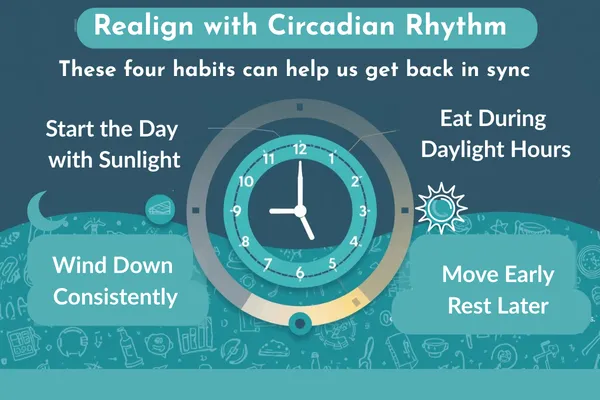
The Longevity Clock: How to Align with Nature’s Rhythm to Slow Down Aging
What if the secret to feeling younger, longer was hiding in the way we move through our day?
Imagine waking up with steady energy, thinking clearly all day, and sleeping deeply each night. Now imagine that same rhythm helping our bodies age more slowly at the cellular level.
This idea isn’t just wishful thinking. It’s rooted in circadian biology—and it’s one of the most powerful lifestyle tools for extending health span and long-term vitality.
Many of us focus on what we eat or how much we move to support our health. But the timing of our daily habits plays an equally important role.
Our bodies run on rhythm. Hormones, digestion, body temperature, and energy patterns follow a 24-hour cycle. This internal timing system—our circadian rhythm—is sensitive to light, food, movement, and rest.
When we align with this natural rhythm, we activate our body’s innate healing processes. We stabilize blood sugar, reduce inflammation, protect our mitochondria, and support the genes that keep our cells resilient. When we disrupt our rhythm, these systems struggle to keep up.
Science
Our circadian clock acts like a conductor, setting the pace for nearly every major function in the body.
Mitochondrial function follows a circadian cycle. Eating late forces mitochondria to stay active when they should be resting and repairing, increasing oxidative stress and accelerating cellular aging.
Chronic inflammation rises when circadian rhythms are disrupted. Inflammatory cytokines increase, which contributes to age-related diseases like cardiovascular disease and neurodegeneration.
Insulin sensitivity is highest earlier in the day. Late-night eating leads to exaggerated glucose responses and increased fat storage over time.
Sirtuins, our longevity-associated genes, are activated through fasting and regular sleep-wake cycles. These genes play a key role in DNA repair and slowing biological aging.
Working with our body’s natural timing supports metabolic flexibility, mental clarity, and cellular resilience.
Solution
Realigning with our circadian rhythm doesn’t require an overhaul. These four habits can help us get back in sync:

Start the Day with Sunlight
Getting outside within the first hour of waking helps reset our internal clock. Natural morning light supports melatonin balance and boosts energy through cortisol regulation.Eat During Daylight Hours
Keeping meals within a 10–12 hour window—starting earlier in the day—gives our digestion and mitochondria time to rest and repair overnight.Wind Down Consistently
Creating a calm evening routine with dim lighting and reduced screen time helps signal to our brains that it’s time to rest. Consistent sleep improves everything from glucose control to immune health.Move Early, Rest Later
Morning movement reinforces our wake-sleep rhythm. Gentle stretching or walking is ideal early in the day, while intense evening workouts may interfere with melatonin production.
Takeaway
Our body’s rhythm is one of the most powerful influences on how we age.
When we structure our day around light, nourishment, movement, and rest, we create a strong foundation for longevity. Our cells can repair. Our metabolism works efficiently. Our energy stays steady.
Healthy aging isn’t something we chase in the future. It’s something we build today—one aligned habit at a time.
References
Panda S. Circadian physiology of metabolism. Science. 2016;354(6315):1008–1015. doi:10.1126/science.aah4967
Reinke H, Asher G. Circadian Clock Control of Liver Metabolic Functions. Gastroenterology. 2016 Mar;150(3):574-80. doi: 10.1053/j.gastro.2015.11.043. Epub 2015 Dec 2. PMID: 26657326.
Chaix A, Zarrinpar A, Miu P, Panda S. Time-restricted feeding is a preventative and therapeutic intervention against diverse nutritional challenges. Cell Metabolism. 2014;20(6):991–1005. doi:10.1016/j.cmet.2014.11.001

